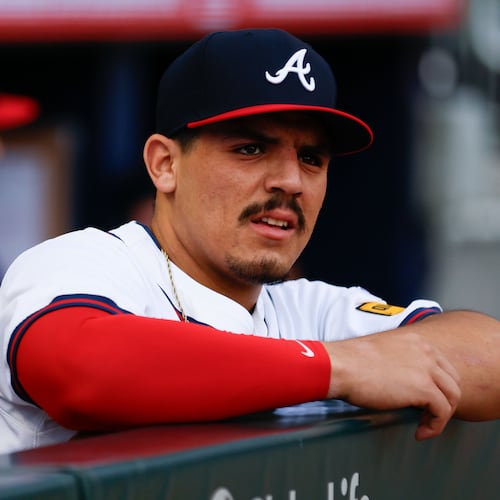The Braves held their first draft meeting 11 days ago. They reached a consensus that placed the name Carter Stewart atop their board.
On Monday, they made their top-rated player the latest young arm to join the organization’s pitching-laden system.
Stewart, a right-hander from Eau Gallie High School (Melbourne, Fla.), was the Braves’ No. 8 overall pick in the first round of the 2018 MLB draft.
» More: Braves draft outfielder with second pick
“About a week or so now I felt like the Braves were a high possibility, that they might draft me,” Stewart said. “And when they called my name, it was a surreal feeling. It was definitely exciting.”
The pick wasn’t a surprise: The majority of mock drafts matched the Braves with Stewart. And the franchise’s affinity for prep arms under scouting director Brian Bridges isn’t a secret.
While he wasn’t the first high school arm taken, Stewart was often regarded as the prized prep arm of the 2018 draft. The Padres chose the first high school pitcher, Ryan Weathers, a pick before the Braves.
Stewart’s calling card is a devastating curveball, which Bridges quickly called the best in the class. His spin rate is among the highest ever registered, and would be in the majors.
It was that curveball that’s largely responsible Stewart being was No. 1 overall on the team’s board, Bridges confirmed.
National crosschecker Tom Bautista saw Stewart’s 18-strikeout no-hitter earlier in the season and he was sold.
“He was like ‘Hey man, I don’t know that I’m going to see anything better,’” Bridges said, recalling his conversation with Bautista. “’I don’t think this guy can do any worse. I don’t want to see him again.’”
“It felt good, but I didn’t feel like it was anything special,” Stewart said. “I just went out there trying to have fun pitching. I wasn’t trying to do anything special that game. I was just trying to get outs.”
Stewart realized at an early age his curveball would be more effective than his rendition of a slider. And while he idolizes Astros starter Justin Verlander – known for his slider – Stewart knew his strikeout pitch was his 12-6.
“When I was seven or eight, I always had friends who said my curveball was absolutely nasty,” he said. “So I feel like that might’ve been when I really thought that was a good pitch and a lot of the reason why I stuck with it. It always seemed to be a strikeout pitch.”
His fastball hovers in the low 90s, though he’s been clocked in the 94-96 range and topped at 98 mph, and his changeup is still a work in progress. Scouts would like to see Stewart fill out his 6-foot-6 frame.
That isn’t expected to be an issue. Stewart has put on 30 pounds and grown two inches since August, according to Bridges. In turn, his fastball velocity has increased from the 88-92 mph range it was at the time.
An electric junior campaign put Stewart on the national radar. He earned a 0.81 ERA while striking out 104 in 69-1/3 innings.
His development continued this season, when the righty posted a 0.91 ERA and struck out 128 in 61-2/3 innings. He pitched four complete game shutouts, something he attributed to pacing himself, not throwing 110 percent every pitch.
Bridges recalled watching Phillies starter Nick Pivetta mow down the Braves in Philadelphia on May 21. Pivetta’s seven shutout innings brought Stewart to mind.
“We all know what Pivetta did to us,” Bridges said. “I was watching Pivetta pitch and thought, that could be … Same kind of stuff. I don’t know that Pivetta has that kind of spin rate on his curveball, but that was the similarities. Power arm, power pitcher.”
Stewart is familiar with the present day Braves. He became an Astros fans during their 50-win days, admiring how the franchise committed to building a young, athletic core. Stewart bought into their transition into a “younger spectrum.”
Now he joins a team already bearing the fruits of a similar process.
“I see that a lot with the Braves, that they are already getting a lot better, that they have young talent and they’re good.”
The Braves opted for upside in what might be their last top-10 pick in a while. While a Mississippi State commit, Stewart indicated he expects negotiations with Braves to move quickly.
The team chose Stewart rather than invest in a high school position player, the more immediate help of a college bat, or even a more seasoned arm, such as their Kyle Wright selection last year.
Bridges didn’t budge from his fundamental beliefs. The Braves build with pitching.
“The key is, you have to commit to something,” he said. “So whatever you’re going to commit to, you better buy all into it. There’s no guarantees how things are going to end, it’s a long journey for pitchers, but the more volume you have of quality pitchers, the better chance you have to sustain winning at the major league level, in my opinion.”
About the Author
Keep Reading
The Latest
Featured



